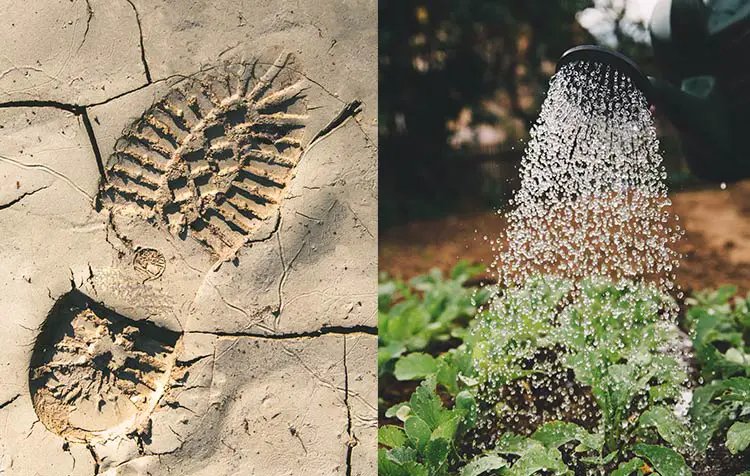What is actually meant by the water footprint? Water is the blood of the earth and the most important food for basically all living beings. We need it in the household for showering, cooking or washing clothes - and also the things we consume could not be grown or produced without water. Unfortunately, we consume far too much water, both directly and indirectly, which in turn has a negative impact on the environment and society. Water scarcity problem tighten.
It's good that the water footprint is a useful tool for identifying where water is consumed and how water-friendly one's life actually is. Accordingly, it is also easier to classify to what extent one can further reduce one's own water consumption in everyday life.
In this article, I would like to give you everything you need to know about the water footprint. From the definition, about water-intensive foods and everyday products, to the calculation and valuable tips for improvement. Let's go!
What is the water footprint?
We humans consume water directly (e.g. when showering or washing clothes) but above all indirectly (so-called virtual water, e.g. for watering the food we eat). The water footprint is ultimately the Total water consumed directly and indirectly - i.e. the actual water consumption of a country, a company, a household or even an individual consumer.₁
The amount of water consumed by a product even takes into account information on the consuming region and also the producing region. This is important because consumption often takes place in one's own country, but production in another country has consumed water. In such a case, one speaks of the external water footprint. The internal water footprint on the other hand, describes the water consumption of production and consumption in one's own country.
And what do you do with the water footprint? With the help of the value determined, you know - for example as a consumer or state - how much water you consume within a year. You can then make targeted optimizations accordingly.
Why reduce your own water footprint? For example, to address environmental issues such as global water scarcity in times of Climate change counteract.
Green, blue and gray virtual water
To calculate a meaningful water footprint, a distinction is made in virtual water between green, blue and gray water.
- Green virtual water: This is used soil and rainwater from the natural water cycle. It is therefore water that is stored in the soil and is not particularly influenced by humans.
- Blue virtual water: It describes the water used from rivers see or groundwater, which is used, for example, in the artificial irrigation of plants or filling livestock watering.
- Gray, virtual water: This is water that has been impaired during use and can only be reused to a limited extent. For example, because it is contaminated with pesticides or fertilizers in agriculture. Finally, gray water describes the amount of water that is necessary to dilute the impurities according to the water quality regulations.
Which consumer goods have high, virtual water consumption?

Here I present you a informative list of the most water-intensive everyday products based on data from waterfootprint.org and also, more tangibly, convert consumption into filled bathtubs (one bathtub = about 153 liters). With the help of this knowledge, you can switch to more water-friendly alternatives and improve your personal water footprint.
Foods
| Foods | Water consumption | "Bathtubs" | Proportion (green, blue, gray) |
| Chocolate | 17196 l / kg | approx. 112 | 98%, 1%, 1% |
| Beef | 15415 l / kg | approx. 100 | 94%, 4%, 3% |
| Sheep meat | 10412 l / kg | approx. 68 | 94%, 5%, 1% |
| Pork | 5988 l / kg | approx. 39 | 82%, 8%, 10% |
| Butter | 5553 l / kg | approx. 36 | 85%, 8%, 7% |
| Chicken | 4325 l / kg | approx. 28 | 82%, 7%, 11% |
| Eggs | 3266 l / kg | approx. 21 | 79%, 7%, 13% |
| Cheese | 3178 l / kg | approx. 20 | 85%, 8%, 7% |
| Peanuts | 2782 l / kg | approx. 18 | 89%, 5%, 6% |
| Rice | 2497 l / kg | approx. 16 | 68%, 20%, 11% |
| Pasta | 1849 l / kg | approx. 12 | 70%, 19%, 11% |
| Coffee | 1056 l / l | approx. 6 | 96%, 1%, 3% |
| Orange | 560 l / kg | approx. 3 | 72%, 20%, 9% |
| … | … | … | … |
Other consumer goods
| Consumer Goods | Water consumption | "Bathtubs" | Share |
| Car | 400000 l (approx.) | approx. 2614 | n.a. |
| Computer | 20000 l (approx.) | approx. 133 | n.a. |
| Leather (cow) | 17093 l / kg | approx. 111 | 93%, 4%, 3% |
| Smartphone | 13000 l (approx.) | approx. 86 | n.a. |
| Biodiesel (soy) | 11397 l / l | approx. 74 | 95%, 3%, 2% |
| Cotton shirt | 2495 l / 250 g | approx. 16 | 54%, 33%, 13% |
| Jeans pants | 8000 l (approx.) | approx. 52 | n.a. |
| … | … | … | … |
How to calculate the water footprint?
The water footprint makes visible the (often invisible) water consumption for one's own lifestyle and encourages changes in personal behavior. Calculators like the Water traffic light from Weltfriendensdienst e.V. usually reveal the incredibly large potential for minimizing one's own water consumption.
Annotation: In the calculator, unfortunately, you can not specify that you completely renounce certain foods. Only "little" can be specified there, which is why it is still somewhat ambiguous for vegans. Nevertheless, the tool is a useful means of identifying personal potential for saving water.
Here I would like to give you a few facts about the global and Germany-wide water consumption:
- Germany: Germany's water footprint is around 120 billion cubic meters of water per year. Only 31 percent of this is attributable to use in its own country. Around 69 percent of the water is consumed abroad.₂
- Per capita: Every German consumes an average of about 3900 liters (the equivalent of about 26 full bathtubs) of water a day.₁ (only 121 liters of this comes directly from the tap).
- Worldwide: The global water footprint is estimated at 9 trillion tons per year. That's almost 300,000 tons of water per second.₃
4 Quick Tips: How can everyone reduce their personal water footprint?

A little freaked out by the numbers and want to improve your personal water footprint? Then here are tips you can implement right away:
- Live Vegan: For animal products (whether food or clothing), for example, the water-intensive cultivation of animal feed, water in the watering troughs and stable cleaning are essential. By eliminating animal products and avoiding the "animal detour," you will significantly improve your water footprint. More at vegan life.
- Eat regionally and seasonally: Out of season and in warm climates, many foods require much more water to grow. Therefore nourish yourself regional and seasonal.
- Go for high quality clothing: The longer your sweaters and shirts last, the less often you'll have to buy new clothes and the less water will be used for the water-intensive cultivation of cotton, for example. And if a new purchase is unavoidable, you can prefer clothes made from linen or hemp, which are grown in a less water-intensive way.
- Less electronics: Think minimalist and limit your ownership of electrical appliances to the bare essentials. Also, don't keep buying the latest smartphone model and have it repaired when it doesn't work.
In the article Reduce water consumption in everyday life you will get many more tips!
Can you think of any other tips to positively impact your own water footprint? Then feel free to write me a comment under the post.
Know and specifically improve water footprint
The ecological footprint you probably already know - now you also know the water footprint. It describes the total amount of water we use directly and, above all, indirectly. If you have your own Making life more sustainable you should calculate it and reduce or even completely stop consuming water-intensive food and objects. The thought that other people, animals and ultimately yourself suffer from your own water-intensive lifestyle should be motivation enough.
Do you have any questions, tips or suggestions about the water footprint? Then I look forward to your comment!
Stay sustainable,

PS.: The freshwater resources in ponds, rivers and lakes of this world are limited. Drinking water consumption is therefore also one of the Planetary boundaries. In the linked article you can learn more about the factors that describe how well or badly the earth is doing.
References:
₁ Federal Environment Agency: Water footprint (as of 03.05.2022), available at https://www.umweltbundesamt.de/themen/wasser/wasser-bewirtschaften/wasserfussabdruck. [11.05.2022].
₂ Mekonnen & Hoekstra (2011) National Water Footprint Accounts, UNESCO-IHE, available at https://www.waterfootprintassessmenttool.org/national-explorer. [11.05.2022].
₃ The World Counts: The consumer society is powered by water, available at https://www.theworldcounts.com/challenges/planet-earth/freshwater/global-water-footprint/story. [11.05.2022].





